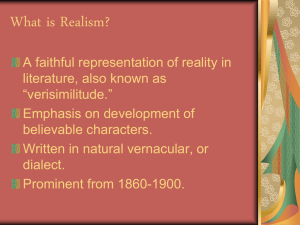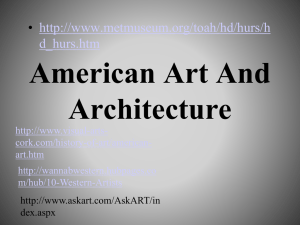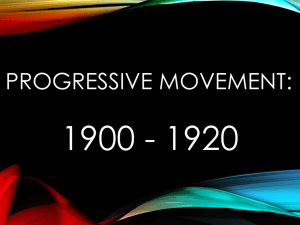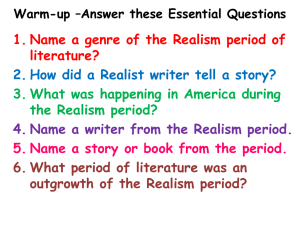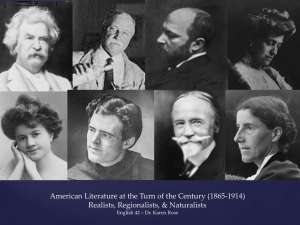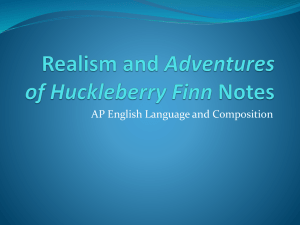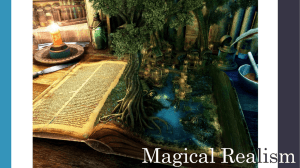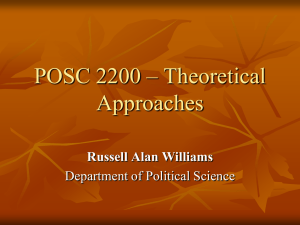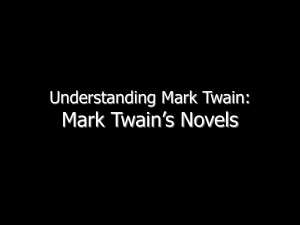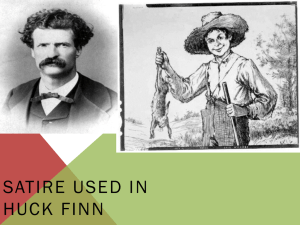Realism
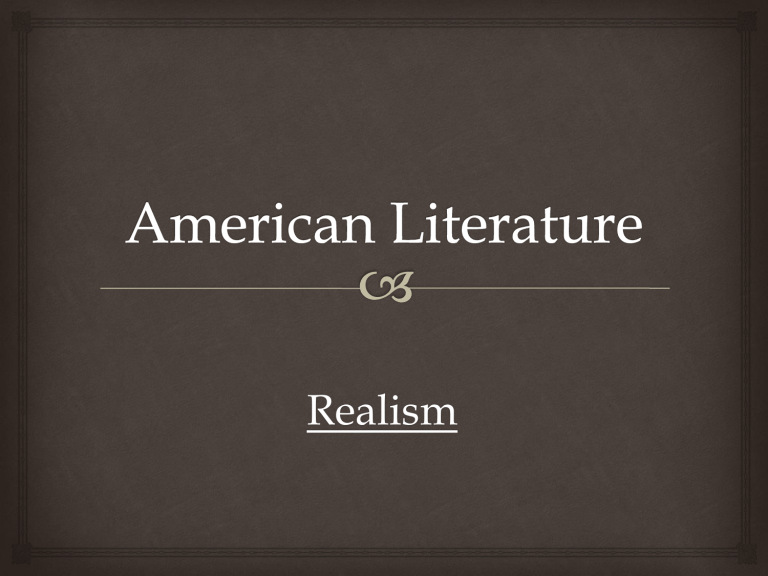
Realism
Agenda
Attendance and announcements
Three corners activity
Power point lecture/presentation on Realism
Two pages of Cornell notes and graphic organizer
Guided notes/Think, pair, share
Exit activity – Evaluation question/debrief
Homework- Complete your Cornell notes and graphic organizer
Common Core Standards
Reading Standards (RL): 1, 2, 3, 4, 5, 6, 9
Writing Standards (W): 2a, 2b, 2c, 2d, 2e, 2f, 4, 7, 9, 10
Speaking and Listening Standards (SL): 1a, 1b, 1c, 1d,
2, 3, 5
Language Standards (L): 1a, 1b, 2, 3, 4a, 4b, 4c, 4d, 5a,
5b, 6
Outcomes of the lesson
Timeline overview of American Literary Movements
Emphasis on Realism, beginning with the philosophic, historic and economic context.
Literary Characteristics of Realism: Writing style, major themes, methods of interpretation and author’s intent of Realism works
Notable writers of the Realism era and their works
Introduce Mark Twain
The Adventures of Huckleberry Finn – major themes and analysis
Three-Corners Activity
Essential question:
To what degree does society shape who you are?
Think about this question for one minute, and then move to corner of the room that best expresses your personal philosophy.
Individualism. “Be yourself no matter what anyone says.”
Adaption. “When in Rome, do as the Romans do.”
Conformity. “Tradition is a guide, not a jailer.”
Once you are in your group, work together to develop a justification statement, with personal evidence, on why this philosophy holds true
(two minutes). Select a spokesperson to share aloud.
Prior Knowledge Inquiry
Transcendental eras of literature.
Education and Literacy had become a major progressive reforms and this led to an increasing demand for literary work relevant to the working class.
Knowing this, what themes do think were pronounced in realist literature?
How do you think literature for the commoner might differ from the literature written for the elite?
Point of View Inquiry
Of his literary masterpiece, The Adventures
heart and a deformed conscience come into collision and conscience suffers defeat.”
Realism was a literary movement grounded in human experience.
Innate moral reasoning clashes with the banked and hegemonic ideological “truth” to construct meaning and perception of real life. One complex theme of realism – the double consciousness – was widely applied by writers and artists of the era. Knowing that Twain, and other realist thinkers developed and intensified the tension between societal norms and a person’s instinctual moral reasoning, how do you think the concept of double consciousness might be defined?
Think, pair, share
Knowing that Twain, and other realist thinkers developed and intensified the tension between societal norms and a person’s instinctual moral reasoning, how do you think the concept of double consciousness
might be defined?
Literary Movements
Puritan Era
Age of
Reason
Romanticism
Transcendentalism
Realism
Modernism
Contemporary and Post-
Modernism
1600 - 1750 1750 - 1800 1800 - 1840 1840 - 1855 1865 -
1915
1916 - 1946 1946 -
Present
American Literature Timeline
Realism
Transcendental Era
1840-1855 1860-1910
Modernism
1910-1940
Post-Modernism
1940-present
Realism in American Literature
American Realism Timeline
Charlotte Perkins Gilman (1860-
1935) The Yellow Wallpaper
Willa Cather (1873-
1947) My Antonia
Upton Sinclair (1878-
1968) The Jungle
Mark Twain
(1835-1910) The
Adventures of
Huckleberry Finn
Henry James (1843-
1916) Portrait of a
Lady
Stephen Crane (1871-1910)The Red
Badge of Courage
John Steinbeck
(1902-1968) Of
Mice and Men
Frederick Douglass (1818-
1895) Narrative of the Life of
Frederick Douglass, an
American Slave
William Dean Howells
(1837-1920) The Rise of
Silas Lapham
Kate Chopin
(1850-1904) The
Awakening
1860-1870 1870-1880
Edith Wharton (1862-
1937)The Age of Innocence
1880-1890 1890-1990
Jack London
(1876-1916) White
Fang
1990-1910
Introduction to American Realism http://education-portal.com/academy/lesson/the-literary-realism-movementa-response-to-romanticism.html#lesson
American Realism Resources
http://education-portal.com/academy/topic/realismin-literature.html
Realism in Literature
The literary movement, Realism was a reaction against Romanticism and
Transcendentalism. Realism was given philosophical ground through
German Idealism, American pragmatism, economic theories and further, it was assigned social obligations by the progressive movements. While the Romantics and Transcendentalists may have, at times, tried to escape the elements and conditions of space and time for a positive idealism, the Realists stared factual circumstances in the face, investigating and documenting them so that honest voices could be heard, and problems could be addressed and resolved.
Historic/Economic Context of American Realism
1860-1910
Industrial
Revolution/Gilded Age
Redistribution of wealth
Captains of Industry/Robber
Barons
Social Darwinism/Laissez
Faire economics
Rise of the working/middle class
Socialism/Communism/
Marxism
Political Machines
Unions
Major Historical Events
1860-1910
1862 Homestead Act/Unions
1862 - 1863 Emancipation
Proclamation
1863 - 1870 Reconstruction of the
South
1860 - 1990 Railroad development
1879 – Thomas Edison invents the first light bulb
1905 – Sherman Anti-Trust Act
1860 – 1910 numerous progressive reforms
Social
Movements
Progressive social reforms
Unions/Labor
Muckrakers
Immigration/Competitive labor force
Slave trade/Emancipation/
Reconstruction/Freedman’s
Bureau
Education and literacy/literate working class/unions/worker’s rights
Printing press and availability of books/widespread literacy
Child labor/foundlings
Suffrage
Food and Drug Administration –
Public Health
Environmental conservation
Think, pair, share
If you were to write a Realist novel in and about the early 20 th century, which social problem would you have chosen this subject?
to address? Do you have ethos with
Explain why you would have chosen this topic and explain how you would have angled your work for a moral resolve and solution.
The Conscience and
Consciousness of
Realism
“What’s the use of you learning to do right, when it’s troublesome to do right and ain’t
no trouble to do wrong, and the wages is just the same? I was stuck. I couldn’t answer that. So I reckoned I wouldn’t bother no more about it, but after this always do whichever come handiest at the
time.”
~Huckleberry Finn
Christianity was seen as both institutional and hierarchical/divine ordering of authority vs. Social Justice and Social Gospel applications of Christian values developing community.
The life of the mind, Moral development, double-consciousness, cognitive dissonance are primary themes in literature.
Essential question: What role does society play in shaping who we are?
Primary Literary Characteristics of Realism
Marriage between investigative journalism and literature – journalistic muckraking investigations were applied to the novel to expose a social problems.
Renders reality closely and in comprehensive detail. Selective presentation of reality with an emphasis on verisimilitude.
Character is more important than action and plot; complex ethical choices are often the subject.
Characters appear in their real complexity of temperament and motive; they are in explicable relation to nature, to each other, to their social class, to their own past.
Class is important; the novel has traditionally served the interests and aspirations of an insurgent middle class. (See Ian Watt, The Rise of the Novel)
Events will usually be plausible. Realistic novels avoid the sensational, dramatic elements.
Diction is natural vernacular, not heightened or poetic; tone may be comic, satiric, or matter-of-fact.
Objectivity in presentation becomes increasingly important: overt authorial comments or intrusions diminish as the century progresses.
Internal thoughts or psychological realism is a variant form.
In Black and White Strangers, Kenneth Warren suggests that a basic difference between realism and sentimentalism is that in realism, “the redemption of the individual lay within the social world,” but in sentimental fiction, “the redemption of the social world lay with the individual” (75-76).
(from Richard Chase, The American Novel and Its Tradition)
Literary Characteristics of
Realism – Character
Development
Emphasis on the development of consciousness of the character over events and adventures
Strength in characters and subject matter (development of consciousness about the themes) over the course of the plotline
Characters were complex (rather than good or bad, hero or villain of myth, they mediated and reasoned in between)
Character development is often internalized, it is a psychological process
Psychological Motivations, interests, desires, fears
Moral development – changes in mood, perception, consciousness, opinions and ideas constitute the turning points and climaxes, rather than events in the plot
Realism did not follow the arch of events of traditional models, rather they tried to emulate life patterns, and psychological development, where the “life of the mind” collided with the external circumstance, and the characters had to discern a truth or make-making about their experience.
These techniques made realist more like life, never completely knowable, always changing
Literary Characteristics – Style and Construction
Often apply frame narratives, or story inside a story, and they are told by an unreliable narrator to be more honest about the way human experience life.
“You don’t know about me, without you have read a book by the name of “The Adventures of Tom see anybody but lied, one time or another, without it was Aunt Polly, or the widow, or maybe Mary.
Aunt Polly – Tom’s Aunt Polly, she is – and Mary, and the Widow Douglas, is all told about in that
book – which is mostly a true book; with some stretchers,” as I said before” (3).
No omniscient narrator, rather an unreliable narrator who may not have all the information or show bias, perceptions are colored by their beliefs, and have their own flaws and internal conflict
Attention to minute details; effort to capture the true essence of reality without judgment
Presence in time and in the moment; carefully constructed spaces, voices and conversations
Objectivity and fidelity to the facts of the matter, rather than emotional responses
Added notes and
Summary
Realist writers, unlike the Transcendentalists (New England), came from all over the country.
Realist writers that focused only on the peasantry and expendables were called
Naturalists.
Faithful representations of reality – verisimilitude
Representation of middle class life, or the lower classes
Realism has been called a “strategy for imagining and managing the threats of social change”
Replicate natural speech phonetically – the vernacular speech patterns and local vocabulary were applied considering how they sound to the imagination
Focused on middle and lower class characters, rather than the elite
Double-consciousness, cognitive dissonance, playing double, moral development
Think, pair, share
Select two or three of the literary characteristics of
Realism and explain how they assign and support a moral and social imperative in Realist writing.
Read through the following quotes carefully and
Quotes from/about some characters of American Realism
“He became quicker of movement than the other dogs, swifter of foot, craftier, deadlier, more lithe, more lean with iron like muscle
have held his own nor survived the hostile environment in which he found himself.”
― Jack London, White Fang
“Its time we woke up,” pursued Gerald, still inwardly urged to unfamiliar speech. “Women are pretty much people, seems to me.
I know they dress like fools - but who’s to blame for that? We invent all those idiotic hats of theirs, and design their crazy fashions, and what’s more, if a woman is courageous enough to wear common-sense clothes - and shoes - which of us wants to dance with her?”
― Charlotte Perkins Gilman, The Yellow Wallpaper
“It was all so very businesslike that one watched it fascinated. It was porkmaking by machinery, pork-making by applied mathematics. And yet somehow the most matter-of-fact person could not help thinking of the hogs; they were so innocent, they came so very trustingly; and they were so very human in their
them up in this cold-blooded, impersonal way, without pretense at apology, without the homage of a tear. ”
― Upton Sinclair, The Jungle
“A man with a full stomach and the respect of his fellows had no business to scold about anything that he might think to be wrong in the ways of the universe, or even with the ways of society. Let the unfortunates rail; the others may play marbles.”
― Stephen Crane, The Red Badge of Courage
“Women ought to be free - as free as we are,' he declared, making a discovery of which he was too irritated to measure the terrific consequences.”
― Edith Wharton, The Age of Innocence
Think, pair, share
Choose one quote for this activity from one of these Realist works.
Distinguish how the passage demonstrates the social conditions and environment within the personality and thinking of the character/creature.
Do his/her circumstances result from social constructions or from their own free will? Explain.
How does the personality of the character/narrator reveal traces of nature over nurture, vice versa or both? Explain your justification.
Mark Twain
S. Clemens at age 15
(left) and
Twain with his family
(below).
Mark Twain was born Samuel Langhorne
Clemens (November 30, 1835 – April 21,
1910) in Florida, Missouri to Jane Lampton and John Marshall Clemens. Samuel was the sixth of seven children, however only three of the seven children survived to adulthood. the Mississippi, which would provide the setting for both Tom Sawyer and Huckleberry
Finn. Missouri was a slave state, and from a young age, Samuel became acquainted with the institution of slavery and the language applied to justify it, which he explored and exposed in his writing. When his father passed away at age eleven (his father was an attorney and a judge), the young Samuel
Clemens went to work to help support his family. He worked as a printing press assistant/typesetter and journalist, and a steam boat pilot. Young Samuel Clemens was autodidactic, or self-educated. He went to the libraries every evening and read from a wide variety of sources.
The Author of
The Adventures of Huckleberry Finn,
Mark Twain
http://education-portal.com/academy/lesson/mark-twainbiography-works-and-style-as-a-regionalist-writer.html#lesson
Write three memorable facts about Mark Twain that inspired and informed his written work.
How was Mark Twain shaped by society? How does this social influence resonate in his writing? How did he understand and respond to the stimulation of his environment? Was Twain’s interpretation of his environment good, bad or both? Explain.
The Adventures of Huckleberry Finn
Themes and Analysis: http://education-portal.com/academy/lesson/the-adventures-of-huckleberry-finnthemes-and-analysis.html#lesson
Plot Summary and Characters: http://education-portal.com/academy/lesson/the-adventures-of-huckleberry-finnsummary-and-analysis.html#lesson
Evaluation Question
“It made me shiver. And I about made up my mind to pray, and see if I couldn't try to quit being the kind of a boy I was and be better. So I kneeled down. But the words wouldn't come. Why wouldn't they? It warn't no use to try and hide it from Him. Nor from ME,
give up sin, but away inside of me I was holding on to the biggest one of all. I was trying to make my mouth SAY I would do the right thing and the clean thing, and go and write to that n----’s owner and tell where he was; but deep down in me I knowed it was a lie, and He knowed it. You can't pray a lie--I found that out.”
― Mark Twain, The Adventures of Huckleberry Finn
This passage from Huckleberry Finn reveals Huck’s inner tension as he navigates (mediates) between the moral terrain of social norms, expectations and laws decreed by society, and what he instinctually senses to be true about the human condition. Huck states that he was “playing double.” Evaluate how the development of Huck’s internal consciousness pushes the external events of story
forward, or how external conditions influence Huck’s evolving
thinking and being.


